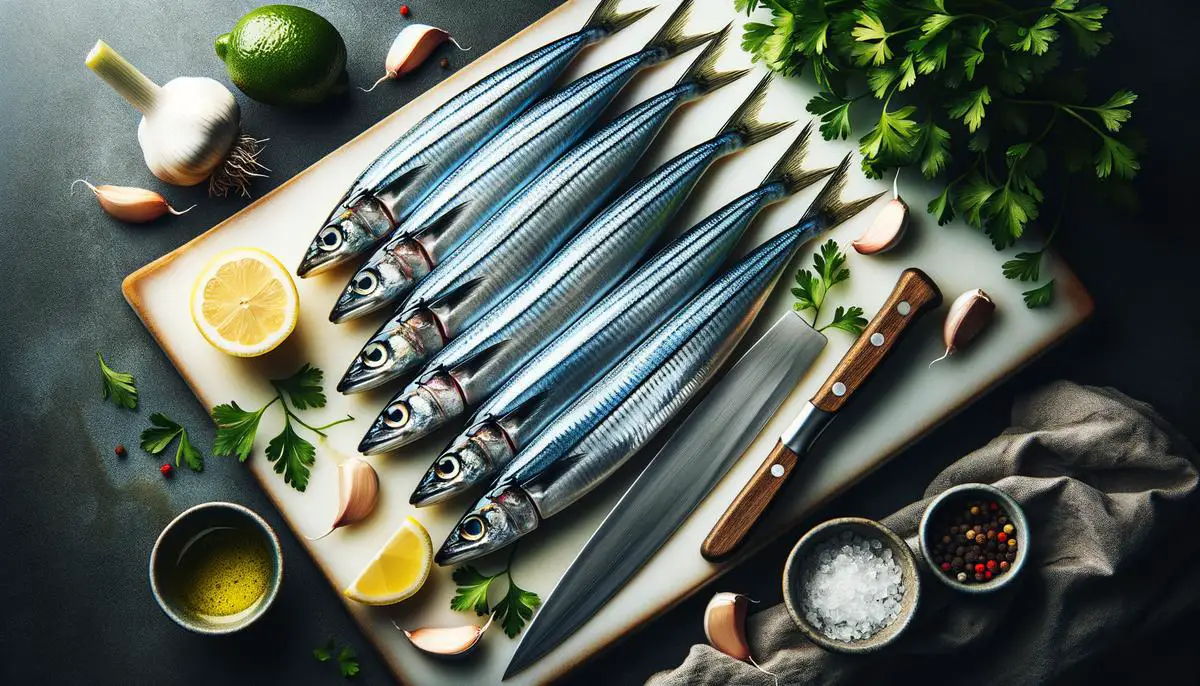
Exploring the world of Shishamo, a delightful smelt fish revered in Japanese cooking, opens up a panorama of flavors and culinary experiences. Freshness is paramount, elevating the simple act of cooking into a celebration of taste and texture. This article guides you through the essential steps of selecting, preparing, and cooking Shishamo, ensuring that every bite is a testament to its natural elegance. With attention to detail and a respect for the ingredient, we will discover how to unlock the full potential of this exquisite fish.
Selecting Fresh Shishamo
Ensuring the Freshness of Shishamo Before Cooking
When venturing into the culinary world of Shishamo, a small smelt immensely popular in Japanese cuisine, the freshness of the fish transforms the eating experience. Fresh Shishamo brings a delicate balance of sweetness and umami, characteristic of seafood straight from the water. Here’s how to confirm the freshness of Shishamo before it graces your pan.
- First and foremost, inspect the appearance. Fresh Shishamo boasts a shiny, metallic sheen with taut skin. Dullness or discoloration, especially towards brown or yellow, signals age or improper handling. Trust your eyes; they’re your initial gauge.
- Next, examine the eyes. In fresh fish, the eyes appear bright, clear, and somewhat bulging. Cloudy, sunk, or discolored eyes often indicate that the Shishamo is past its prime, veering away from its peak culinary potential.
- The smell test cannot be understated. Fresh Shishamo should smell like the ocean, slightly briny with a hint of sweetness. Any pungent, fishy, or ammonia-like odors are red flags. Fresh seafood should never make you recoil at its scent.
- Feel the texture. Gently press the flesh. It should be firm, springing back immediately. If your finger leaves an imprint or the flesh feels mushy, the Shishamo is not at its freshest.
- Lastly, take note of the gills if visible. Rich, bright red gills are a hallmark of freshness. Faded, brown, or slime-coated gills suggest the fish has been out of water for a considerable time and its quality compromised.
By becoming attuned to these indicators – appearance, eyes, smell, texture, and gills – you’ll proudly select Shishamo that brings the essence of the sea directly to your table, ensuring a sublime culinary experience with each cook.

Preparing Shishamo for Cooking
Essential Preparation Steps for Shishamo Before Cooking
Before diving into the process of cooking Shishamo, a beloved Japanese smelt often served grilled, it’s crucial to engage in proper preparation to enhance its flavor and ensure the best culinary experience. The prep work is not overly complicated but requires attention to detail, paying homage to the delicate nature of this fish. Follow these steps to prep your Shishamo like a chef:
- Cleaning: First things first, cleaning the fish is paramount. Begin by running cold water over the Shishamo to rinse off any lingering scales or debris that might be clinging to its skin. Even though their scales are minor and don’t necessarily need removing, ensuring the fish is clean sets the stage for a pleasant eating experience.
- Gutting: Although Shishamo is often cooked and served whole, including its roe, it does need to be gutted to remove any bitterness and unnecessary innards that could detract from its naturally mild, smoky flavor. Make a shallow incision along the belly and gently remove the guts. This step is delicate because if you plan to cherish the roe, which is a prized part of enjoying Shishamo, you need to ensure it remains intact.
- Salting: After your Shishamo is cleaned and gutted, it’s time to salt them. Lightly sprinkle sea salt over the fish. This not only seasons the fish but also helps in drawing out any excess moisture, contributing to a crispier skin upon grilling. Let them sit with the salt for about 10 to 15 minutes. Salt proportion is key—too little and it won’t enhance the flavor, too much and it will overpower the delicate taste of the fish.
- Patting Dry: Before moving on to cooking, pat the Shishamo dry with paper towels. Excess surface moisture can interfere with the grilling process, preventing the skin from achieving that desirable crispiness. This step is about finesse; be gentle to avoid damaging the skin or dislodging the precious roe.
- Skewering (Optional): If you want to elevate your Shishamo presentation and ensure they cook evenly, consider skewering them. Using metal or pre-soaked bamboo skewers, gently thread them through the fish. This not only makes handling easier, especially when grilling, but it also adds a visually appealing element to the dish, reminiscent of authentic Japanese street food.
By adhering to these preparation steps, your Shishamo is now primed for cooking, be it grilling, broiling, or even pan-frying. The aim is to highlight the natural flavors and textures of the fish, making every bite a testament to the care put into its preparation. Remember, the joy of cooking lies in the details, and with Shishamo, every step from selection to prep enhances the final experience on the plate.

Cooking Techniques for Shishamo
Capturing the delicate flavors of Shishamo, a small but mighty fish revered in Japanese cuisine, requires precision and a gentle touch in cooking techniques. Beyond the preparatory stages, the method you choose to cook Shishamo can make or break its subtle taste profile. Here, we delve into the cooking techniques that honor its natural flavors.
Grilling
: Perhaps the most traditional method, grilling Shishamo over charcoal or a gas flame brings out a smoky essence that complements its briny sweetness. Keep the grill at a medium heat to avoid charring the skin too quickly. Lightly oil the grill to prevent sticking, placing the fish directly over the heat. The key is to turn them just once, allowing the skin to crisp up without losing moisture from the inside. This method accentuates the fish’s natural flavors, with the skin becoming a crispy delight.Broiling
: For those without access to a grill, broiling is an excellent alternative. Preheat your broiler and position the rack so the fish will be about 4-6 inches from the heat source. Lay the Shishamo on a foil-lined baking sheet for easy cleanup. Watching closely, broil the fish for 2-3 minutes on each side or until the skin blisters and takes on a golden brown color. Broiling offers a faster approach while still achieving a desirable texture and flavor.Pan-Frying
: If you seek a more hands-on method, pan-frying in a light oil allows for an incredible texture contrast. Use a non-stick pan or well-seasoned cast iron skillet with just a thin layer of oil heated over medium. Once hot, place the Shishamo in the pan, being careful not to overcrowd. Fry each side until golden brown, typically 2-3 minutes per side. The direct heat from the pan crisps the skin beautifully while keeping the interior juicy.Serving Suggestions
: Regardless of the cooking method, Shishamo is best enjoyed with minimal adornments. A light squeeze of fresh lemon juice or a dab of mayonnaise can enhance its flavors without overwhelming. Accompany with steamed rice and a simple vegetable side for a balanced meal.In executing these techniques, the aim is to respect and elevate Shishamo’s delicate taste. The culinary journey from preparation to cooking should be approached with care, ensuring that the inherent qualities of this cherished fish are brought to the forefront of the dining experience.

Mastering the selection, preparation, and cooking of Shishamo transforms it from a mere ingredient to the star of the dining table. Each step taken with care and respect for the fish’s delicate nature articulates the difference between a simple meal and a memorable dining experience. Shishamo, with its subtle flavors and rich texture, serves not just as food, but as a bridge to understanding the depth and sophistication of Japanese cuisine. Let every carefully prepared bite of Shishamo remind us of the beauty in simplicity, and the art inherent in cooking.



